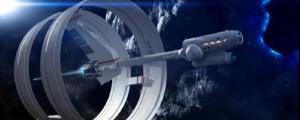Blog
When I See
An Elephant Fly
1 May 2015
 Mark Rademaker
Mark RademakerI’ve been getting a number of questions about NASA’s supposed discovery of a warp drive engine, and I’ve been resisting writing about it. Partly because I’ve written about it before, and partly because of the difficulty in separating the facts from wild speculation. Unfortunately none of the results have been submitted to peer review, so there’s no clear summary of the work that one can point to. That also means it hasn’t been publicly vetted, which is absolutely vital for this kind of claim. It should also be stressed that NASA hasn’t said they’ve discovered warp drive. They haven’t said anything on the matter. The buzz is coming from discussions on a site called NASA Spaceflight, which is not affiliated with NASA. With that in mind, what seems to be the evidence one way or the other?
The discussion centers on a so-called “reactionless drive.” That is, a device that can produce a thrust without a corresponding propellant. The idea is extremely controversial, because such a device would violate Newton’s third law (of action-reaction) which is one of the foundational laws of physics. There are actually two devices that claim this effect. One is known as the EmDrive, developed by Roger J. Shawyer, and the other is the Cannae Drive, developed Guido Fetta. Both of these devices bounce radio waves inside a resonant chamber to create a reactionless drive. The buzz this time around seems to be about the EM drive.
About a year ago, an EM drive experiment found a thrust of about 50 micronewtons. This is an extraordinarily small force, less than the weight of a small snowflake, but it’s not zero. This experiment was performed at atmospheric pressure, so the effect could have easily been due to experimental error. For example, uneven heating across the device could cause the air around it to recoil with different energies, causing a net thrust. We see a similar effect with a Crookes radiometer. This year a similar experiment has been done in a vacuum (about 5 microtorr) and again measured a thrust of about 50 micronewtons. That basically eliminates the atmospheric effects, but there are other more technical effects that could still be producing a false positive. The experiment has also been done in different orientations, and there seems to be directionality to the thrust. That would seem to work against the idea that the device is somehow coupling to the Earth’s magnetic field.
There has also been a basic experiment where a Michelson interferometer was placed next to the device. In principle, such a device could measure any variation of spacetime near the device. The results are supposedly consistent with the theoretical warping of an Alcubierre drive effect (which is a theoretical warp drive). What “consistent with” actually means is unclear, but that’s why so many popular articles are claiming “NASA accidentally discovers warp drive!” No scientist is actually claiming that.
On the face of it, this might seem pretty promising. A thrust has been observed, it seems to work in a vacuum, and there are hints of a warp effect. Here’s why we shouldn’t plan a party just yet. To begin with, one does not simply violate a fundamental law of physics. There are several ideas proposed to explain the thrust as a real effect, but they all involve a violation of basic physics. If this device is real, then Newton’s third law will have to be either thrown out or seriously revised. That by itself doesn’t mean the effect is false, since in the end the evidence wins. But history shows that long established scientific principles are very robust. I don’t doubt that the teams working on these devices are in earnest, but it is frustratingly difficult to account for all extraneous effects, particularly with such a small result. More than one scientist has thought they were on to something that didn’t pan out.
Which brings me back to my original statement that the work hasn’t been submitted to peer review. Much of it is hearsay based on discussion groups. While I’ve tried to present an even-handed summary, all of this should be read with an extremely skeptical eye. Both the EM drive and Cannae drive fans are claiming a violation of basic physics. Extraordinary claims require extraordinary evidence, and the threshold of evidence hasn’t remotely been reached yet. Is it interesting? Sure. Is it valid? We have no idea (but lots of reasons to doubt), and until formal evidence is submitted to peer review there is no reason to assume it’s real.